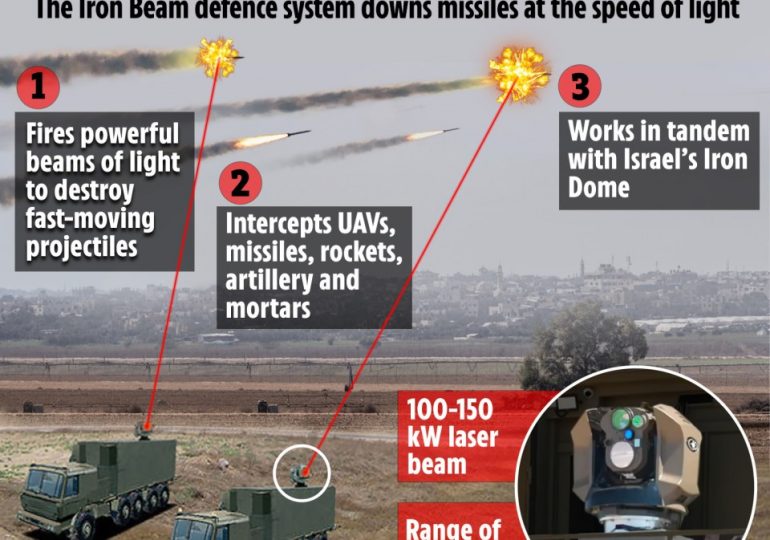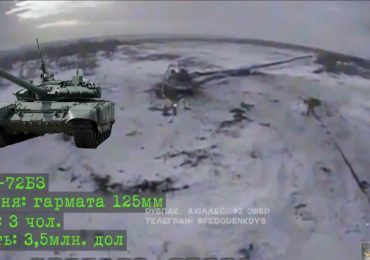ISRAEL’S new Iron Beam laser guns can down missiles at the speed of light – and are set to be deployed to the battlefield.
The mobile air defence system fires powerful beams of light into the sky to turn fast-moving projectiles into dust.
Ministry of DefenseWith a 100-kilowatt laser beam and a range of 7km, the Iron Beam destroys missiles with ‘pinpoint accuracy’[/caption]
Iron Beam was developed by Rafael Advanced Defence Systems
It was designed as as a cheaper alternative to work alongside Israel’s famous Iron Dome.
It is the sixth element of Israel‘s huge missile defence system – joining the Arrow 2, Arrow 3, David’s Sling and Iron Dome.
Iron Beam was developed by Rafael Advanced Defence Systems and first unveiled in 2014.
Rafeal said it is “designed to intercept a wide range of threats such as from a distance of a few hundred metres to up to several kilometres”.
With a 100-kilowatt laser beam and a range of 7km, Iron Beam wipes out threats with “pinpoint accuracy”, causes little collateral damage, and costs almost nothing per use, the company said.
For use both on land and at sea, the system can protect vessels from drone swarms and anti-ship missiles.
Former Israeli prime minister Naftali Bennett dubbed the laser guns a “strategic game changer for Israel and the world”.
It was previously scheduled to be deployed in 2025 but the outbreak of war with Gaza means Israel is reportedly carrying out tests to get it into operation much sooner.
Dr Yehoshua Kalisky – from the Institute for National Security Studies – believes the system could be operational imminently.
He told The Telegraph: “Maybe they’re working on it tonight and tomorrow they will succeed. I think it will be operational very soon.
“The laser works. The only problem that I see is to integrate it into all the early warning systems.
“It’s not a standalone system. It must be coupled with all the air defences. If it’s not integrated then it would be useless.”
Uzi Rubin, a missile defence expert at the Israeli Ministry of Defence, said the Iron Beam is a cheaper alternative to the Iron Dome system.
Instead of costing $60,000 for each firing of the Iron Dome, he said a laser beam can cost “just a few dollars”.
And there’s no need for ammunition, making it easier to move and to conceal.
Other benefits include unlimited number of firings, lower operational costs, and less manpower.
But, unlike the Iron Dome, it’s not an all-weather air defence system.
The Iron Dome can be operated in all weather conditions – including fog, dust storm, low clouds and rain.
But the Iron Beam system doesn’t work effectively in wet conditions as the water particles absorb the laser’s energy.
It also needs a direct line of sight between the system and its target – making its placement far more important – and it has a much slower rate of fire.
Although the laser beam makes its way to the target at the speed of light, it takes several seconds to destroy short-range missiles.
The Iron Dome, however, destroys the target within a millisecond.
It makes it difficult for the Iron Beam to destroy a barrage of multiple rockets and missiles.
The laser beam also loses power and “dilutes” as it moves through the air – making its impact on the target less powerful.
It means the Iron Beam might be a better system for projectiles that only fire short distances – such as mortars.
“The range is limited, more limited than the range of an interceptor weapon, even a short-range interceptor weapon,” Rubin told the Wall Street Journal.
Many countries are trying to develop their own laser missile defences.
In 2021, Rafael revealed it was teaming up with American defence giant Lockheed Martin to “explore opportunities and technology implementations” based on the development on the Iron Beam system.
Although there are a number of advantages to using the laser missile defence, questions have been raised about power, cooling and range.
As well as the Iron Beam system, Israel already boasts the Iron Dome – one of the first missile interceptor of its kind in the world.
It an all-weather air defence system designed to destroy short-range rockets and 155mm artillery shells fired from a distance of 4km to 70km.
Also developed by Rafael, it intercepts rockets that are travelling in the direction of a urban areas and brings them down.
Israel hopes to increase the range of the dome’s interceptions to 250km and make it able to stop rockets coming from two directions.
The system was ready for use in March 2011 and in April 2021 it had successfully intercepted a BM-21 Grad launched from Gaza for the first time.
In 2012 The Jerusalem Post claimed the Iron Dome had shot down 90 per cent of rockets launched from Gaza.
It is part of a future multi-tiered missile defence system being developed by Israel, but each interception rocket launch costs $50,000.
The dome is made up of missile batteries which are shaped like giant match boxes and are tilted in the direction of Gaza.
Leave a comment
















